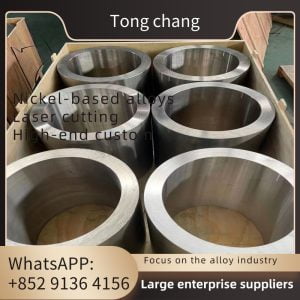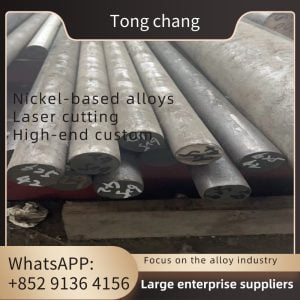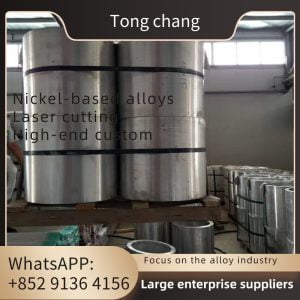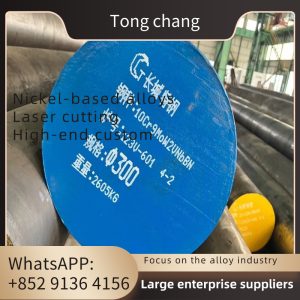| 产品名称 | 合金钢 | 标准: | 美国材料试验协会 A335 / 美国机械工程师学会 SA335 |
|---|---|---|---|
| 材料 | Gr.p5,p9,p11,p12,p21,p22 , p91 | O.D.: | 1/2′ 至 24 |
| 长度 | 单随机,双随机和剪切长度 | 结束: | 平端,斜端 |
| 类型 | 无缝 | 包装 | 胶合木箱/铁箱/带塑料盖的捆绑箱 |
| 申请: | 电力行业,石化厂,锅炉管,石油和天然气应用 | ||
| 强光 | T92 合金钢无缝管, T91 合金钢无缝管, ASME SA213M-2013 锅炉管 | ||
ASTM A335 / ASME SA335 P91 高温合金钢
美国标准A335/SA335 P91 是一种铁素体合金钢,具有非常高的强度性能,不会随时间推移而退化,并具有抗蠕变性。根据其成分,它也被称为 9 Cr 1 Mo 钢或铬钼钢管。合金 P91 管的主要合金元素是铬(Cr)、钼(Mo)和钒(V)。P91 的具体成分通常包括约 9% 铬和 1% 钼,以及碳、锰、硅和氮等其他元素。其他合金牌号可能具有针对特定应用的不同成分。
主要材料
ASTM A335(用于高温环境的无缝铁素体合金钢管)
标准 A335 P1,P2,P5,P9,P12,P11,P22,P91
ASTM 213(无缝铁素体和奥氏体合金钢锅炉、过热器和换热管)
ASTM A213 T1,T2,T11,T5,T9,T22,T23,T91,T92
A335 P91 级钢管等效材料
| 美国材料与试验协会 | ASME | 等效材料 |
|---|---|---|
| A335 P 91 | ASME SA 335 P91 | 1.4903, K90901, X10CrMoVNb9-1 |
A335 P91 级钢管等效材料化学要求
| 要素 | 等级 | P-5 | P-9 | P-11 | P-22 | P-91 | P-91 还应包括以下内容 |
|---|---|---|---|---|---|---|---|
| UNS 名称 | K41545 | S50400 | K11597 | K21590 | K91560 | ||
| 碳 | 0.15 最大值 | 0.15 最大值 | 0.05 - 0.15 | 0.05 - 0.15 | 0.08 - 0.12 | V 在 0.18 - 0.25 之间 | |
| 锰 | 0.30 - 0.60 | 0.30 - 0.60 | 0.30 - 0.60 | 0.30 - 0.60 | 0.30 - 0.60 | N 在 0.030 - 0.070 之间 | |
| 磷,最大值 | 0.025 | 0.025 | 0.025 | 0.025 | 0.020 | 镍的最大值为 0.40 | |
| 硫,最大值 | 0.025 | 0.025 | 0.025 | 0.025 | 0.010 | 最大值为 0.02 的铝 | |
| 硅 | 最大 0.50 | 0.25 - 1.00 | 0.50 - 1.00 | 最大 0.50 | 0.20 -0.50 | Cb 为 0.06 - 0.10 | |
| 铬 | 4.00 - 6.00 | 8.00 - 10.00 | 1.00 - 1.50 | 1.90 - 2.60 | 8.00 - 9.50 | 钛的最大值为 0.01 | |
| 钼 | 0.45 -0.65 | 0.90 - 1.10 | 0.44 - 0.65 | 0.87 - 1.13 | 0.85 - 1.05 | 最大 0.01 的锆 | |
| 机械性能 | ||||||
| 等级 | 拉伸强度(兆帕) | 屈服强度(兆帕) | 伸长率(%) | 冲击能量(焦耳) | 硬度 | |
| P11 | ≥ 415 | ≥ 205 | ≥ 22 | ≥ 35 | ≤ 163HB | |
| P12 | ≥ 415 | ≥ 220 | ≥ 22 | ≥ 35 | ≤ 163HB | |
| P22 | ≥ 415 | ≥ 205 | ≥ 22 | ≥ 35 | ≤ 163HB | |
| P5 | ≥ 415 | ≥ 205 | ≥ 22 | ≥ 35 | ≤ 187HB | |
| P91 | 585~760 | ≥ 415 | ≥ 20 | ≥ 35 | ≤ 250HB | |
| P92 | ≥ 620 | ≥ 440 | ≥ 20 | ≥ 35 | 250HB | |
合金 P91 管材与业内常用的其他合金牌号的区别:
合金成分:P91 合金管的主要合金元素是铬(Cr)、钼(Mo)和钒(V)。P91 的具体成分通常包括约 9% 铬和 1% 钼,以及碳、锰、硅和氮等其他元素。其他合金牌号可能具有针对特定应用的不同成分。
高温强度:P91 的主要与众不同之处在于其在高温下的超强强度。与许多其他合金牌号相比,它具有更高的蠕变强度和抗热疲劳强度。这使其适用于发电厂、锅炉和石化工业中的高温应用。
碳含量:与其他一些合金牌号相比,P91 的含碳量更高,这有助于提高其强度和硬度。但是,较高的碳含量也给焊接带来了挑战,需要精确控制输入热量和焊后热处理。
制造和焊接性:P91 合金在制造和焊接方面有特殊要求。它需要精确的预热、中间温度控制和焊后热处理,以避免对材料的微观结构和性能产生不利影响。其他合金牌号可能有不同的焊接程序和注意事项。
应用
A335/SA335 P91 适用于弯曲、翻边(凡斯通)和类似的成型操作以及熔焊。常用于以下用途。
发电
石油和天然气工业
化学加工
工业锅炉
热交换器








